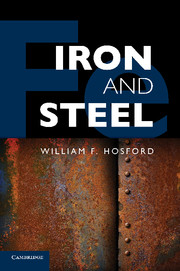Book contents
- Frontmatter
- Contents
- Preface
- 1 General Introduction
- 2 Early History of Iron and Steel
- 3 Modern Steel Making
- 4 Constitution of Carbon Steels
- 5 Plastic Strength
- 6 Annealing
- 7 Deformation Mechanisms and Crystallographic Textures
- 8 Substitutional Solid Solutions
- 9 Interstitial Solid Solutions
- 10 Diffusion
- 11 Strain Aging
- 12 Austenite Transformation
- 13 Hardenability
- 14 Tempering and Surface Hardening
- 15 Low-Carbon Sheet Steel
- 16 Sheet Steel Formability
- 17 Alloy Steels
- 18 Other Steels
- 19 Stainless Steels
- 20 Fracture
- 21 Cast Irons
- 22 Magnetic Behavior of Iron
- 23 Corrosion
- Appendix I Physical Properties of Pure Iron
- Appendix II Approximate Hardness Conversions and Tensile Strengths of Steels
- Index
- References
14 - Tempering and Surface Hardening
Published online by Cambridge University Press: 05 May 2012
- Frontmatter
- Contents
- Preface
- 1 General Introduction
- 2 Early History of Iron and Steel
- 3 Modern Steel Making
- 4 Constitution of Carbon Steels
- 5 Plastic Strength
- 6 Annealing
- 7 Deformation Mechanisms and Crystallographic Textures
- 8 Substitutional Solid Solutions
- 9 Interstitial Solid Solutions
- 10 Diffusion
- 11 Strain Aging
- 12 Austenite Transformation
- 13 Hardenability
- 14 Tempering and Surface Hardening
- 15 Low-Carbon Sheet Steel
- 16 Sheet Steel Formability
- 17 Alloy Steels
- 18 Other Steels
- 19 Stainless Steels
- 20 Fracture
- 21 Cast Irons
- 22 Magnetic Behavior of Iron
- 23 Corrosion
- Appendix I Physical Properties of Pure Iron
- Appendix II Approximate Hardness Conversions and Tensile Strengths of Steels
- Index
- References
Summary
Tempering
Martensite is brittle. To make it tougher, it is normally heated to temper it. Tempering involves a complex series of reactions that gradually break down martensite. What happens is usually described in stages. The first stage occurs at the lowest temperature (shortest time) and involves transformation of retained austenite. In the second stage, carbon is redistributed within the martensite to dislocations. Generally, stress relief occurs during this stage. Precipitation of ɛ carbide (Fe2.4C) and η carbide (Fe2C) from the martensite comprises the third stage. This precipitation lowers the carbon content of the martensite. In stage four, remaining austenite decomposes to cementite (Fe3C) and ferrite. Finally, in stage five, the transition carbides and low-carbon martensite form more ferrite and cementite. These reactions overlap.
There is a gradual loss of hardness throughout tempering (except stage one) at increasing temperatures. This is shown as a function of the carbon content, as shown in Figure 14.1. Figure 14.2 shows the effect of tempering temperature on the properties of 4340 steel. The amount of tempering depends on the carbon content (Figure 14.3) as well as time and temperature (Figure 13.4), although the effect of time is much less than that of temperature.
- Type
- Chapter
- Information
- Iron and Steel , pp. 150 - 166Publisher: Cambridge University PressPrint publication year: 2012



